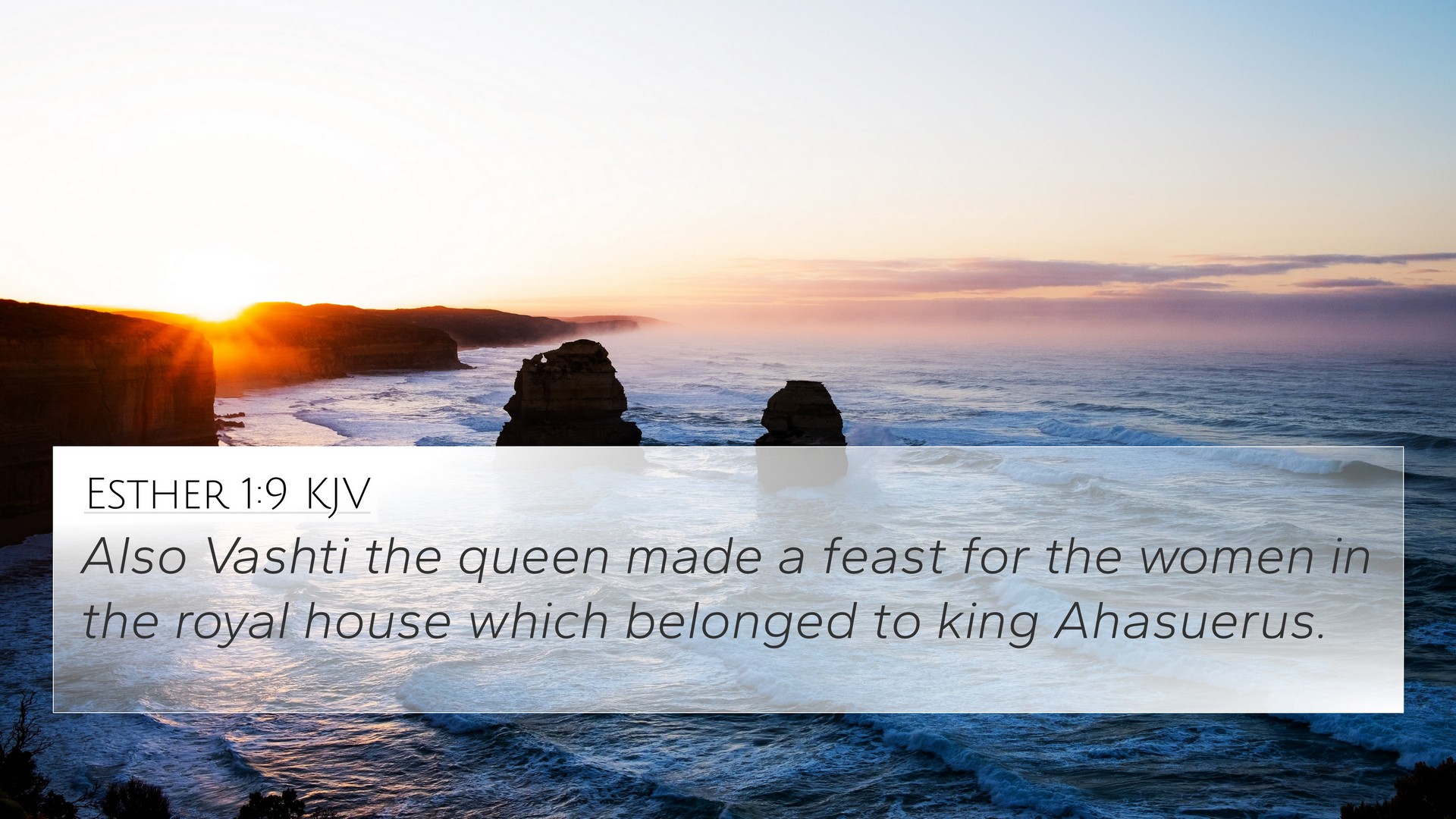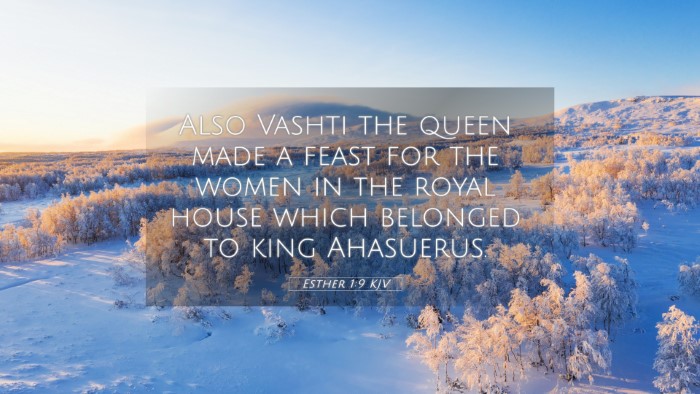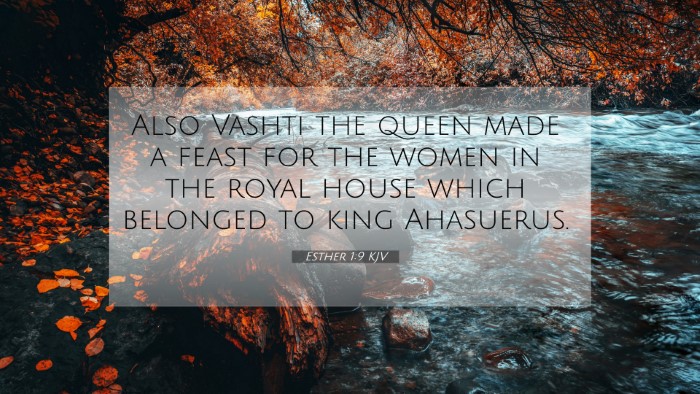Old Testament
Genesis Exodus Leviticus Numbers Deuteronomy Joshua Judges Ruth 1 Samuel 2 Samuel 1 Kings 2 Kings 1 Chronicles 2 Chronicles Ezra Nehemiah Esther Job Psalms Proverbs Ecclesiastes Song of Solomon Isaiah Jeremiah Lamentations Ezekiel Daniel Hosea Joel Amos Obadiah Jonah Micah Nahum Habakkuk Zephaniah Haggai Zechariah MalachiEsther 1:9 Similar Verses
Esther 1:9 Cross References
Also Vashti the queen made a feast for the women in the royal house which belonged to king Ahasuerus.
Uncover the Rich Themes and Topics of This Bible Verse
Listed below are the Bible themes associated with Esther 1:9. We invite you to explore each theme to gain deeper insights into the Scriptures.
Esther 1:9 Cross Reference Verses
This section features a detailed cross-reference designed to enrich your understanding of the Scriptures. Below, you will find carefully selected verses that echo the themes and teachings related to Esther 1:9 KJV. Click on any image to explore detailed analyses of related Bible verses and uncover deeper theological insights.
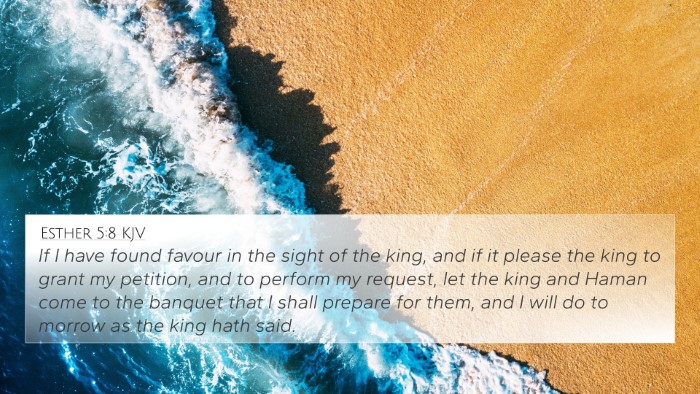
Esther 5:8 (KJV) »
If I have found favour in the sight of the king, and if it please the king to grant my petition, and to perform my request, let the king and Haman come to the banquet that I shall prepare for them, and I will do to morrow as the king hath said.
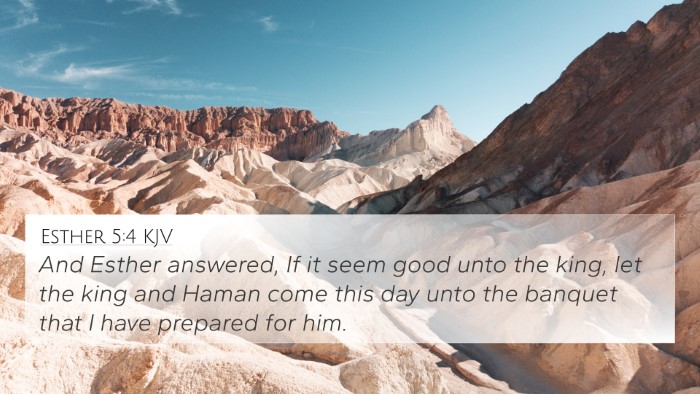
Esther 5:4 (KJV) »
And Esther answered, If it seem good unto the king, let the king and Haman come this day unto the banquet that I have prepared for him.
Esther 1:9 Verse Analysis and Similar Verses
Understanding Esther 1:9: A Comprehensive Analysis
Esther 1:9 states: "Also Vashti the queen made a feast for the women in the royal house which belonged to king Ahasuerus." This brief yet impactful verse offers profound insights into the character dynamics and cultural context of the Book of Esther. With the help of public domain commentaries like those of Matthew Henry, Albert Barnes, and Adam Clarke, we can explore the theological and practical implications of this verse.
Verse Context and Significance
This verse occurs in the early chapters of Esther, which set the stage for the unfolding drama of the Jewish people's deliverance. To fully appreciate the significance of Esther 1:9, one must consider the historical and cultural backdrop, particularly the role of women in ancient Persian society.
- Historical Context: Ahasuerus, often identified as Xerxes I, ruled over a vast empire. In this context, the mention of Vashti, his queen, signifies her influence and the expectations placed upon her.
- Cultural Implications: The feasting and celebration reflect the customs of opulence prevalent among monarchs and serve as a juxtaposition against the more solemn tones of later events in the narrative.
- Gender Dynamics: Vashti’s feast for women represents not just her role as a queen but also the agency women held within specific contexts, complicating the narrative of female subjugation often found in historical texts.
Commentary Insights
Matthew Henry's Commentary emphasizes the rich details of this verse, highlighting the social gatherings of royal households and their significance in maintaining political alliances and social standings. Henry points out that Vashti’s actions could be viewed as defiance against prevailing norms, setting the stage for her eventual fall.
Albert Barnes' Notes offers a practical perspective, noting that the verse illustrates the duality of royal life: while the king feasted with his men, the queen hosted her own separate gathering, underscoring both physical separation and the nuanced roles women played.
Adam Clarke's Commentary explores the implications of Vashti’s feast, suggesting it was more than just a social event; it was a declaration of her status and the power dynamics within the royal household. Clarke elaborates on how this moment leads to larger themes of power, rebellion, and eventual redemption in the narrative.
Bible Verse Cross-References
Esther 1:9 connects to several other scriptures that enhance our understanding of its themes:
- Esther 2:1-4: The introduction of a new queen following Vashti's refusal reveals the consequences of her actions.
- Proverbs 31:10-31: This passage reflects the virtuous character expected of women and speaks to the ideal qualities of a noble woman.
- 1 Peter 3:1-6: Offers insights on the conduct of women, which resonates with the themes of Vashti’s story.
- Genesis 1:26-27: Establishes the equality of man and woman in creation, a theme that echoes through the narrative of Esther.
- Jeremiah 29:11: Though not directly related, the assurance of God's plans presents a thematic parallel to the providential unfolding of events in Esther.
- Ruth 1:16-17: The commitment of Ruth demonstrates a form of agency reflective of female empowerment showcased in Esther.
- Matthew 5:14-16: The call for believers to shine like lights connects with Esther's eventual role as a deliverer of her people.
Thematic Bible Verse Connections
Exploring the connections between Bible verses is essential for a deeper understanding of Esther 1:9:
- Leadership and Authority: The interplay between Ahasuerus and Vashti can be seen in Romans 13:1-2, which discusses the role of authority structures.
- Rebellion and Consequences: Similar themes of rebellion against authority emerge in the stories of Daniel 3, where Shadrach, Meshach, and Abednego face the king's decree.
- Women's Role in Scripture: Analyzing who women are in biblical text through Luke 8:1-3 reveals their significant contributions to the early church.
How to Use Bible Cross-References
Utilizing cross-references enriches our biblical studies:
- Determine the theme or concept you wish to explore, such as "female agency in the Bible."
- Search for related verses using a Bible concordance or Bible cross-reference guide.
- Compare the context and implications of each verse, noting how they inform one another.
Conclusion
Esther 1:9 serves as a pivot point for understanding not only the specific narrative of Vashti and Ahasuerus but also broader themes of power, agency, and divine providence. By cross-referencing key biblical texts and employing tools for Bible cross-referencing, readers can gain a multifaceted understanding of Esther’s story. This allows for a nuanced interpretation that connects with other scripture, enabling a deeper exploration of the connections between Bible verses, themes, and teachings that resonate throughout the entirety of Scripture.
